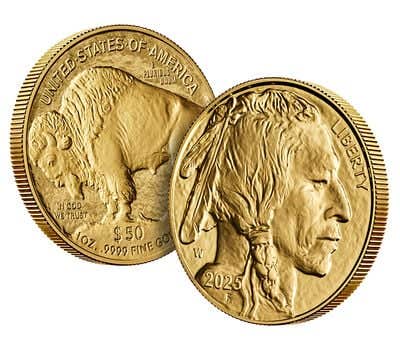No single factor leads to inflation
The modern phenomenon that we have come to call “inflation” is not one thing with a singular cause; it is actually four related but different things.
This article was originally printed in Numismatic News.
>> Subscribe today!
Prices change. Usually, they go up. Less often, they go down. Sometimes, rising prices are truly due to inflation, but not always.
The modern phenomenon that we have come to call “inflation” is not one thing with a singular cause (like the printing of fiat money); it is actually four related but different things.
1) “Classic” inflation. There is a widespread but completely untrue notion out there in the general public that inflation is “too much money chasing too few goods.” This old saw has it all. It’s short, it’s memorable, it’s popularly believed, and it’s pithy. It’s also completely false. It’s why most people shouldn’t commit economics in public. This is the type of inflation that blog writers, precious metal hawkers, and Austrian school economists worry about, pointing to that convenient bogeyman du jour, the Federal Reserve, and frighten you into making bullion purchases above reasonable quantities and prices. The reasoning goes that the government is printing money like crazy, so it will become less valuable, so get out of fiat money and into gold or silver.
How precisely does this mechanism supposedly work? Do merchants and shopkeepers look up the M1 money supply numbers in The Wall Street Journal every morning and say, “Ooh, I have to raise the price on my widgets!” Please. Surely that can’t be it. Inflation is not caused by printing money, even lots and lots of it. Inflation only occurs when the wrong things are done with that money. Inflation is too much (aggregate) income chasing too little production. All that fiat money can’t cause even a tiny ripple of inflation, until and unless it is paid to people for doing nothing of sufficient value. That is the inflationary event, not the printing of the money. If the average guy on the street can’t buy groceries or shoes, inflation is of no worry, no matter what the Federal Reserve does. Even a huge pile of robo-cash on the balance sheets of banks causes no more inflation than does a flea blowing up a balloon.
2) “Real” cost increases. Sometimes, prices increase when there is no inflation. Remember the laws of supply and demand? When scarcity happens, prices rise. Sometimes, the consumables we need become more expensive to go get and produce into consumer goods. Sometimes this happens based on true scarcity, sometimes it happens due to contrived scarcity perpetrated by government actions, such as oil exploration prohibitions, or gratuitous regulations. Amazing as it may seem, prices on some items occasionally rose even when a $20 bill was instantly convertible into a double eagle gold coin. Some of the biggest components of our CPI increases are being driven by transportation cost increases, due to real cost increases, and not inflation at all.
3) Speculatively driven price increases. Sometimes, prices on some things increase (or decrease) merely because people believe they will, and they inadvertently act in such a way as to make the price increase (or decrease) happen. Then they congratulate themselves on being correct, and write blog entries repeating the same prediction. What a system! Do you want examples? Tech stocks in the 1990s. Residential real estate in the first three quarters of the last decade. Nearly anywhere where the idea grabs hold that “things can only go up (or down) from here.” Things like the modern day bullion markets.
Make no mistake, a huge portion of the increase in metals lately is due to the actions of those who have acted in accordance with a belief that the prices would rise. And they were right, because what they did caused the increase. They did it, the gold buyers and the writers whose work they read, whether American, Chinese or Indian, not some press operator at the Bureau of Engraving and Printing, and not even the Chairman of the Federal Reserve.
Any time a commodity increases in price, and public demand to buy more of it actually increases at ever increasing rates, you’re seeing a speculative bubble, nothing more. We’re seeing it more often with every passing month.
Why are all the world’s major currencies being devalued against most widely traded commodities, like gold, silver, or crude oil? Because people believe they will. It’s just that simple. Increasing prices in basic commodities, driven by speculative purchases in those markets, is not a sign of inflation, although it can appear like it is, and it can cause a real inflationary spiral to occur. But the speculators caused the problem themselves; the Federal Reserve did not.
Just because metals traders react irrationally to what the Federal Reserve does, doesn’t mean they rightly get to blame the Federal Reserve for the dire consequences that the metals traders themselves set into motion. It’s their fault, not the Fed’s.
If the “conventional wisdom” of the metals market ever decides we’ve reached a market top, the carnage will be uglier for those holding metals than anything you saw in tech stocks in the late 1990s or Las Vegas or Florida houses for flipping in 2008.
4) “Protected interests” price increases. Some prices are called other things. Some are called fees, or retainers, or wages. Some peoples’ wages are sensitive to the ability of customers to afford their services. Some others have “protected status.” Some wage earners, either directly or through lobbyists, have convinced policy makers that what they do is so important, so crucial, that if their wages were to ever come under downward pressure, the world itself would surely be endangered, so they must be protected at all costs.
We call some of these people physicians, teachers, school administrators, government employees, and attorneys. All are protected, one way or another, from the market forces that have nearly everyone else’s wages under downward pressure. That which cannot be allowed to go down in price will surely increase without apparent limit. Ask yourself a question. Why does the application of high technology lower costs in every field except medicine? Think about it. Medicine is “protected.” Why can’t a friend who once beat a traffic ticket help you with yours unless he’s an attorney? Attorneys are “protected.” Why can’t you have your school taxes lowered if you send your child to a non-public school? Teachers are “protected.”
What’s really happening out there is not that the owner of Sam’s Widget Emporium is raising his prices because Ben Bernanke’s printing press is a menace. What’s more likely is that the core commodities Sam needs to make his widgets have gone up in price due to speculation, his transportation costs are increasing, his property taxes are going up without limit, and his health insurance and lawyer bills are, too. In addition, both our government and China’s are unfairly subsidizing Wong’s Widgets in Shanghai, and Sam’s being forced into unsustainable margins.
So then, what does all this mean to the average guy on the street? It should mean that he has no worries about government printing presses or fiat currency, as long as all that bright shiny crisp currency doesn’t get paid to people to be unproductive. If it does, look out! Bar the door! Inflation is coming!
It also means that he should worry about finding alternatives to things whose real natural economic costs are increasing. He should avoid being seemingly the last one buying into a speculative bubble, for a change, and he should be lobbying, calling, and writing his representatives to reduce the number of protected professions and the degree of their protection.
He should also be lobbying them to spend his tax dollars rebuilding the one and only thing that ever created a middle class in this country, a vibrant unashamed domestic industrial sector, complete with smokestacks and shift workers carrying lunch pails. And if your representative asks whether we need to engage in trade protectionism to accomplish that, the correct answer is, “No more so, or less so, than our trading partners do to protect the sectors that are crucial to their way of life. Why do you ask?”
This Viewpoint was written by V. Kurt Bellman of Harrisburg, Pa. Viewpoint is a forum for the expression of opinion on a variety of numismatic subjects. The opinions expressed here are not necessarily those of Numismatic News. To have your opinion considered for Viewpoint, write to David C. Harper, Editor, Numismatic News, 700 E. State St., Iola, WI 54990. Send e-mail to david.harper@fwmedia.com.
More Coin Collecting Resources:
• Subscribe to our Coin Price Guide, buy Coin Books & Coin Folders and join the NumisMaster VIP Program









